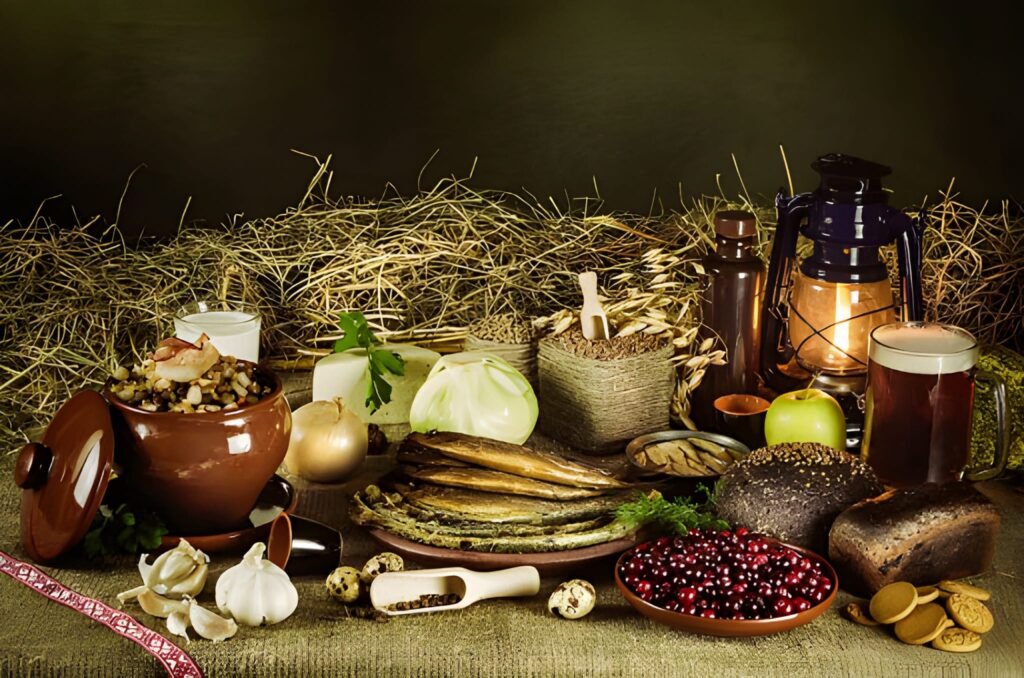A Viking Feast Without Refrigerators
Imagine being a Viking farmer in the 9th century. Winter is coming, your ships are docked, and snow will soon cover the fields. Fresh meat won’t last long in the cold, and there’s no freezer humming in the corner of your longhouse. Instead, you and your family gather around a wooden table, rubbing slabs of meat with salt, hanging strips of fish from rafters, and watching smoke curl up from the fire pit.
That’s the story of Viking food preservation methods, a clever blend of salt curing, drying, and sometimes smoking that kept warriors, farmers, and explorers nourished through long voyages and harsh Scandinavian winters. These weren’t just cooking tricks. They were survival strategies that made Viking expansion across Europe and beyond possible.
Why Viking Food Preservation Methods Mattered
For Vikings, food wasn’t just sustenance; it was security. Preservation methods mattered because they:
-
Allowed meat and fish to last for months, even without refrigeration.
-
Enabled long sea voyages, where fresh food wasn’t available.
-
Prevented famine during harsh winters when hunting and farming slowed.
-
Created portable rations for raiders, traders, and explorers.
Without salt curing and drying, Viking society would’ve struggled to expand. Preserved food was fuel for their ships, strength for their warriors, and stability for their families.
How Vikings Preserved Meat and Fish
Salt Curing: Preserving with Crystals
Salt was precious in the Viking Age. Though scarce in Scandinavia, Vikings traded for it, especially from coastal Europe. Meat and fish were rubbed heavily with salt or soaked in brine. Salt drew out moisture, slowed bacterial growth, and added flavor. While salt wasn’t always abundant, it was highly effective when available.
Drying: Harnessing Wind and Sun
Drying was the most common and accessible method. Strips of fish, venison, or lamb were hung in open air, often in cold, windy environments that prevented spoilage. In northern Norway and Iceland, drying fish created stockfish—a staple that could be stored and traded widely.
Smoking: Flavor Meets Preservation
Though less common than drying, smoking was used to preserve fatty meats and add smoky flavor. Vikings suspended meat above smoldering fires in longhouses, where the combination of low heat and smoke extended shelf life.
Fermentation: A Surprise Technique
Some evidence suggests that Vikings also used fermentation, especially for fish. By burying fish in the ground or storing it in barrels, natural bacteria would ferment it, producing strong-smelling but long-lasting food.
Table: Comparing Viking Food Preservation Methods
| Method | How It Worked | Advantages | Challenges |
|---|---|---|---|
| Salt Curing | Rubbing with salt or soaking in brine | Long-lasting, adds flavor | Salt was rare and costly |
| Drying | Hanging meat/fish in the wind/sun | Simple, no tools needed | Weather-dependent |
| Smoking | Hanging over a smoldering fire | Flavor + preservation | Needed steady fire |
| Fermentation | Storing fish underground/in barrels | Very long-lasting food | Strong odor, acquired taste |
What History Tells Us
Archaeologists have uncovered Viking settlements with drying racks, salt traces, and fish bones that confirm these preservation methods. Norse sagas and historical texts also reference dried cod, cured meats, and smoked foods as staples of Viking life.
According to Smithsonian and National Geographic studies, stockfish was so durable that it became one of the Vikings’ most important trade goods. It fed armies, supported exploration, and remained valuable even centuries after the Viking Age.
Interestingly, written records from medieval Europe often describe Viking food as “simple but strong” perfect for warriors who needed energy more than elegance.
Personal Reflection on Ancient Methods
I once tried drying strips of beef in the open air during a camping trip, curious about how it compared to modern jerky. The taste was rustic, chewy, and smoky from the campfire, nothing fancy, but incredibly satisfying. It gave me a glimpse into what Viking meals might’ve felt like: basic, hearty, and filled with the flavor of the elements.
In my hometown, families still cure fish with salt before drying it in the sun. The smell fills the air, sharp and salty, a reminder that these “ancient” techniques are still alive today.
Cultural Comparisons
Vikings weren’t alone in using salt curing and drying. Other cultures relied on similar methods:
-
Romans cured meats with salt and herbs, influencing European cuisine.
-
Indigenous peoples of North America dried venison and fish into pemmican.
-
Japanese cooks developed methods for drying and fermenting fish, like katsuobushi.
-
African communities sun-dried meats and fish to last through hot climates.
What makes Viking methods unique is how they adapted preservation to a cold, windy environment, turning nature itself into a tool.
Expert Perspectives
-
Smithsonian Institute notes that Viking diets relied heavily on preserved foods, especially dried cod, which fueled voyages to Greenland and North America.
-
National Geographic highlights that stockfish became one of the most traded goods in medieval Europe, with roots in Viking preservation.
-
History.com reports that workers and sailors survived on cured and dried meats, which were vital for travel across seas.
These sources confirm what archaeology and sagas already suggested: without preservation, Viking history might look very different.
Why Viking Preservation Inspires Us Today
Surprisingly, modern foodies and chefs are reviving some of these old methods. Artisanal salt curing, small-batch jerky, and air-dried fish are back in trend, celebrated for their natural, preservative-free approach.
When you think about it, Vikings remind us that preservation isn’t just practical—it’s flavorful. Salt curing enhances taste. Drying concentrates the sweetness. Smoking adds depth. What started as survival has become gourmet.
What This Really Means
When you step back, Viking food preservation methods weren’t just about saving meat. They were about survival in a harsh climate, fueling exploration, and creating trade networks that shaped history. Salt curing and drying turned fragile food into lasting strength.
Every time you eat jerky, smoked salmon, or sun-dried fish, you’re tasting echoes of a Viking longhouse—simple, strong, and built to last.
FAQs on Viking Food Preservation
Q1: Did the Vikings really use salt curing?
Yes, though salt was scarce, they traded for it and used it to cure meats and fish.
Q2: What was the most common preservation method?
Drying was the most widespread, especially for fish like cod.
Q3: Did preserved foods taste good?
By modern standards, Viking food was simple and salty, but it was nourishing and effective.
Q4: How long could dried fish last?
Stockfish could last months, even years, making it ideal for long voyages and trade.



